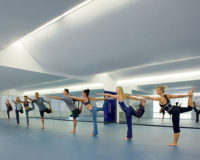Tucson, Arizona
Like many metropolitan areas in the West, Tucson has its share of generic strip malls and sprawling subdivisions. As a native of the desert city, architect Rob Paulus has long aspired to buck the development trend, focusing instead on urban infill, adaptive reuse, and sustainable design. His recent project, 990 Offices, exemplifies this ethos. It also marks the third step in an impressive endeavor to breathe new life into Millville, a vapid industrial zone near downtown.
To fully understand 990 Offices, one must first rewind to 2002, when Paulus took a major leap of faith in urban revitalization. He and his wife, Randi Dorman, president of the Tucson Museum of Contemporary Art, teamed up with two investors to purchase a vacant 80-year-old cold-storage facility in Millville. The architect then embarked on transforming the warehouse into condos — a novelty in Arizona at the time. “This was the first residential loft conversion in the state,” says Dorman. The couple also acquired a roughly 1-acre parcel across the street, where they set out to construct a series of metal-clad, single-family dwellings designed by Paulus.
Both projects were completed in 2005. The 51 “Ice House Lofts” were quickly snatched up (one went to Paulus and Dorman, of course); the nine “Barrio Metalico” homes also sold fast.
The same year, the duo expanded their empire, this time acquiring an adjacent half-acre lot occupied by an auto shop. The shop closed in 2008, and Paulus decided to convert the 30-year-old facility into an office building for his firm and a tenant. “It was a great opportunity to ‘walk the walk’ and create an energy-efficient, naturally lit office with some intriguing landscape features,” he explains.
The building got a major overhaul. Paulus retained the steel framing but otherwise stripped the structure clean. He replaced the walls with an aluminum-clad rainscreen system; heavy insulation helps block heat, thus minimizing energy costs. To bring in natural light, Paulus inserted a clerestory on the building’s south side; on the north — the entrance facade — he replaced roll-up garage doors with glazing that overlooks a courtyard. The building’s northern orientation helps minimize heat gain during the sizzling summer months.
Paulus conceived clever ways to repurpose nearly all remnants of the original structure: Metal garage doors became fencing; broken pieces of concrete were used for paving; and steel beams were made into raised garden beds (yes, this office has an organic vegetable garden).
Inside, the building was divided in half — one side for Paulus, the other for his tenant, Epstein Construction — with a shared bathroom at the core. For his firm, Paulus opted for an open floor plan. With the exception of the walled-off kitchen, furnishings delineate program areas (reception, meeting area, work stations, a library). His tenant, however, wanted enclosed rooms, so the architect created a central corridor lined by traditional offices. “It’s by far the most functional office we’ve ever had,” says Mike Epstein, owner of Epstein Construction.
What is common to both spaces is the undulating wood ceiling, which warms up the grayish interior. “It started out as, Let’s do something to break down the sound and get light coming in,” Paulus says of the design intent. “I also play the violin, and I thought it would be nice if we could mimic its sensuous curves.” The ceiling system comprises pine plywood strips affixed to a suspension grid made of fused sheets of plywood. Skylights allow natural light to pass through the slats and into the work areas below.
Although the project was completed last April, the firm will have its official grand opening party this month, on February 11. To hear Paulus tell it, passersby likely will see guests sitting around the fire pit in the courtyard, listening to someone strum a guitar. They might even spot his 6-year-old daughter roasting marshmallows. “Since we live across the street,” he says, “the office courtyard has become an extension of our outdoor living area.” Through his remarkable efforts in Millville, this Tucson architect is proving that even a gritty, lifeless urban area can be delightfully transformed.
Architect:
Rob Paulus Architects Ltd
990 East 17th Street Suite 100
Tucson, AZ 85719
Completion Date: April 2010
Gross square footage: 4292 sq. ft.
Total construction cost: $343,360
PeopleOwner: Randi Dorman & Rob Paulus Architect: Personnel in architect's firm who should receive special credit: Project architect: Liz Farkas Team members: Andrew Hesse, Bill Mackey Interior designer: Rob Paulus Architects Engineer(s): Electrical Engineer: GLHN Architects & Engineers Consultant(s) General contractor: Mega Trend Inc Photographer(s): Bradley Wheeler CAD system, project management, or other software used: |
ProductsStructural system: existing metal building Exterior cladding Roofing Windows Glazing Doors Metal doors: Steel Dor Tucson (exterior) Wood doors: 1¾” Solid Core, Arizona Sash and Door Hardware Cabinet hardware: IKEA “Lansa” pulls Interior finishes Suspension grid: “Ribs”: Two layers of ½” plywood lapped together; hung with suspension ceiling wire Demountable partitions: 3x3 tube steel and 16 GA mill scale sheet steel partition Cabinetwork and custom woodwork: IKEA flush panel door cabinets Paints and stains: Dunn Edwards Low-VOC Paints Wallcoverings: 5/8” Gypsum board Counters: 16 GA mill scale sheet steel countertops Special surfacing: 16 GA mill scale sheet steel at restroom walls Furnishings Reception furniture: steel angle, wood door, hat channel Chairs: Ron Arad Fantastic Plastic Elastic chairs Tables: custom; steel angle and laminated birch plywood Lighting Downlights: MR16 cable spot lights; RAB vaportight fluorescent Exterior: Progress Lighting, Cylinder Outdoor Wall Lantern (building mounted); Focus Lighting, Directional Landscape Spot Light (landscape lighting) (All exterior lighting uses LED light bulbs) Controls: Intermatic; Leviton Plumbing Add any additional building components or special equipment that made a significant contribution to this project: |










Post a comment to this article
Report Abusive Comment